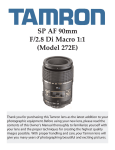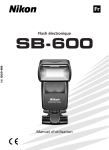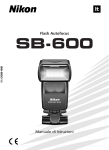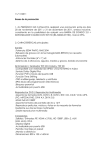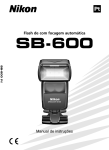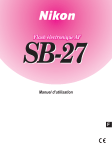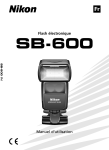Download Tamron AFB01C700 Camera Lens User Manual
Transcript
SP AF 180mm F/3.5 Di LD [IF] Macro 1:1 (Model B01) Thank you for purchasing this Tamron lens as the latest addition to your photographic equipment. Before using your new lens, please read the contents of this Owner's Manual thoroughly to familiarize yourself with your lens and the proper techniques for creating the highest quality images possible. With proper handling and care, your Tamron lens will give you many years of photographing beautiful and exciting pictures. NOMENCLATURE 1. Lens hood 2. Hood attaching alignment mark 3. Hood attaching bayonet ring 4. Filter Effect Control (FEC) Ring (B01) 5. Focusing ring 6. Focus macro magnification scale display 7. Distance (macro magnification) scale 8. Distance (macro magnification) index 9. Depth-of-field scale 10. Tripod socket (B01) 11. Tripod socket fixing screw (B01) 12. Aperture ring (Nikon) 13. Aperture scale (Nikon) 14. AE lock button 15. Aperture index (Nikon) 16. Aperture scale for finder display (Nikon) 17. Lens mount/Lens mount contacts 18. Lens attachment mark (Canon, Minolta) SPECIFICATIONS B01 Focusing Distance Maximum Aperture Angle of View 180mm F/3.5 14º Lens Construction 11/14 Minimum Focus Distance 0.47m Maximum Magnification Ratio Filter Size 1:1 72mm Length 165.7mm Diameter 84.8mm Weight 920g * Lengths, diameters and weights listed in lens specifications are for lenses with Nikon mounts. * Features and cosmetic designs of lenses listed in this owner's manual may be revised without notice. ATTACHING LENS TO CAMERA How to mount the lens Remove the rear cap of the lens, align the lens attachment mark on the lens barrel with its counterpart on the lens mount of the camera and insert the lens mount into camera's mount opening. Rotate the lens clockwise until it click-locks. For Nikon models, align the lens attachment mark with the dot on the camera and rotate the lens counter-clockwise until it click-locks. How to detach the lens Press the lens release button of the camera, turn the lens counter-clockwise (clockwise in case of Nikon), and lift the lens off the camera's lens mount. * For further details, please read the instruction manual of your camera. SWITCHING BETWEEN AF & MF MODES (Ref. Figs. 5 & 6) Nikon and Canon models Simply move the focusing ring forward (to AF) and backward (to MF) to change the focusing mode between autofocus (AF) and manual focus (MF). Minolta modelsMove the focusing ring forward (to AF) and backward (to MF) and at the same time, set the AF/MF selector switch of the camera body to the coinciding focusing mode (AF or MF). Mount AF/MF Switching Operation Nikon, Canon Move focusing ring only Minolta Move and switch both focusing ring and selector of camera body * Carefully read "Autofocus" and "Manual focus" sections below and operate the camera and lens accordingly. In addition, please refer to the instructions related to focusing operations of your camera. FOCUSING (Autofocus) (Ref. 5 & 6) 1. Set the camera in the AF mode, and move the focusing ring upward to the AF position. 2. Press the shutter release button half-way while looking through the viewfinder. The focusing ring will move automatically to focus. * With Minolta cameras, when focusing ring is set in the manual focus position while the camera is set in AF mode, the focusing ring rotates as if it were in the autofocus mode. Turning of the focusing ring in this instance may cause damage to the lens and/or the camera body. Also, do not force the focusing ring when it is set in the manual focus mode. FOCUSING (Manual Focus) Nikon and Canon models 1. Simply move the focusing ring backward to the MF position. 2. Rotate the focusing ring manually while looking through the viewfinder until the image in the finder comes into sharp focus. Minolta models 1. Switch the AF/MF selector switch on the camera body to MF mode, then slide the focusing ring backward to the MF position. 2. Rotate the focusing ring manually while looking through the viewfinder until the image in the finder comes into sharp focus. * Before rotation of the focusing ring, make sure that the camera is set to the MF mode. Manual rotation of the focusing ring when the camera is till set in AF mode will cause mechanical damage to the lens and/or to the camera body. * When using the lens on Nikon F-501 (N2020), please use the switches both on camera body and the lens in order o select MF or AF. * When the focusing ring is set to the AF position, the focusing ring rotates freely and you cannot adjust focus. * If you use the lens in the manual focus mode on an autofocus camera, rotate the focusing ring while holding the shutter release button depressed half-way. The focus confirmation indicator will light when subject comes into focus. * Because B01 uses an internal focus mechanism, the lens does not extend (grow longer out of the front of the camera) even during macro photography. This prevents large loss of balance during focusing. * The focusing ring rotates beyond the infinity position in order to properly focus to infinity under a variety of environmental conditions. When manually focusing, make sure the subject at infinity is sharp in the viewfinder. LENS APERTURE AND AE MODE (Ref. Fig. 7) Setting lens f-n numbers with Canon & Minolta cameras Set the f-number with aperture setting device of the camera body in accordance with the selected photographing mode. Setting lens f-n numbers with Nikon Depending on the photography mode, it is possible to set the aperture on either the lens aperture ring or on the camera body. Setting the aperture on the aperture ring Set the lens aperture ring so it is on the smallest f-stop for a Nikon camera, then set the fstop you want with the indicator. LENS APERTURE AND AE MODE (Ref. Fig. 7) (con’t) Setting the aperture on the camera Set the lens aperture ring so it is on the smallest f-stop for a Nikon camera, then set the fstop you want with the indicator of the camera body. * The lens aperture varies with focusing movement. Cameras read the different lens openings and automatically adjust the exposure properly. * For further details, please read the instruction manual of your camera. ATTACHING THE LENS HOOD (Ref. Figs 1, 2, 3 & 4) 1. Align the index mark on the hood with the corresponding index mark on the lens. Place the hood onto the hood's attaching bayonet ring. 2. Turn the hood clockwise until it clicks. The index mark (O) on the hood appears on the top when it is correctly attached. Stowing lens hood on the lens 1. Detach and reverse the lens hood. Then align the index mark (O) on the hood with the index mark on the lens. Place the hood onto the hood's attaching bayonet ring. 2. Turn the hood clockwise until it clicks. The index mark on the hood appears at the top when correctly stowed. TRIPOD SOCKET (Ref. Figs. 8 & 9) B01 has a socket for tripods. Secure the camera to the tripod with the tripod socket when you use a tripod. Changing the vertical and horizontal position of the camera 1. Turn the tripod's locking knob in a counterclockwise direction to loosen it. 2. Rotate the camera using the lens as the axis, and align the indicator on the tripod socket ring and the vertical and horizontal indicator. 3. Tighten the locking knob and lock the camera into place. Removing the tripod socket 1. Turn the tripod's locking knob in a counterclockwise direction, and line up the white mark on the top of the knob and the tripod socket. 2. Pull the tripod socket's locking knob outward. Open the tripod socket ring, and remove the tripod socket. TRIPOD SOCKET (Ref. Figs. 8 & 9) (con’t) Attaching the tripod socket 1. Open the tripod socket ring, and set the lens. 2. Make sure that the white mark on the top of the tripod socket locking knob and the indicators on the tripod socket are aligned, and then pull the knob outward. 3. Close the ring, and tighten the tripod socket locking knob. * Hold the camera firmly when removing the tripod socket so that you do not drop the camera or the lens. * Make sure that the white mark on the top of the knob and the indicators on the tripod socket are aligned before you pull on the knob. FILTER EFFECT CONTROL B01 features a new mechanism that allows you to rotate the filter with the hood on. Rotation of the ring (4. Filter Effect Control Ring), which is near where the filter attaches, triggers rotation of the filter allowing you to adjust the effect of the PL filter. * The Filter Effect Control Ring and the filter rotate opposite to each other. When you rotate the Filter Effect Control Ring in a clockwise direction, the filter rotates in a counterclockwise direction. * The rotation angle of the Filter Effect Control Ring is different from that of the filter. If you wish to rotate the PL filter to an exact position using the index as a standard, remove the hood and rotate the filter while keeping an eye on the index mark. * You can change the visual effect by rotating PL and non-PL special effect filters such as a cross filter. ABOUT MACRO PHOTOGRAPHY From infinity to the macro zone, you can use AF or MF operation. Since the distance scale and the magnification scale are imprinted side by side, you can get a general idea of the magnification when shooting a picture. B01 Minimum Focus Distance Maximum Magnification Ratio Magnification Scale 0.47m 1:1 1:10 - 1:1 * For the correlation between the photographic distance and photographic magnification, please refer to table 12. EXPOSURE RATE When the lens is moved outwards to increase the magnifications ratio for shooting closeups, the actual brightness on the film decreases, and the effective F number changes. For auto exposure photographing, using an external exposure meter, or when using and external light-adjusting flash however, the exposure must be corrected for this decrease in brightness according to the magnification ratio. For the amount of the correction, refer to table 12. DEPTH-O OF-FFIELD With a camera equipped with a depth-of-field preview button or an aperture-stop-down mechanism, the depth of field can be directly observed through the viewfinder screen of your camera. For the operational details, read the instruction manual of your camera. INFRARED PHOTOGRAPHY Please be aware that there is no infrared index line on any models listed in this owner's manual. Therefore practically no black-and-white infrared film can be used with these lenses. PRECAUTIONS IN SHOOTING Do not use the lens hood when using the camera's built-in flash. Also, when shooting closeups, the lens unit may obstruct the light of the flash even when not using the lens hood, resulting in vignetting at the bottom part of the image. Thus, we recommend using a special externally mounted flash or flash photography. Also refer to the section of your camera's instruction manual pertaining to the use of the built-in flash. When using a B01 with a tele-converter, use the manual focus. When a tele-converter is used with the macro lens, the autofocus may not operate correctly, depending on the focusing distance. This is due to the camera's mechanical system. Use a Tamron tele-converter with a Tamron lens or best results. Tele-converters produced by other manufacturers may not mount properly and/or cause malfunctions. When a tele-converter is mounted onto a lens, the focusing ring normally feels heavier when rotating. When using the lens in macro range, it may be necessary to use a tripod to avoid camera shake. Using high-speed film (ISO 400 or faster) with a fast shutter speed is also helpful to reduce the influence of camera shake. Do not forcibly turn the focusing ring when camera and/or lens is/are set in the AF mode. Doing so could damage the lens and/or camera. Certain camera models may indicate the maximum aperture values of the lens as approximate numbers. This is inherent to the design of the camera and not an indication of error. TO ENSURE LONG-T TERM SATISFACTION Avoid touching the glass element surface. Use a photographic lens cloth or blower brush to remove dust from the lens element surface. When not using the lens, always place a lens cap on it for protection. Use a lens cleaning tissue or lint cloth with a drop of cleaning solution to remove fingerprints or dirt on the glass lens surface with a rotary motion from the center to the edge. Use a silicon cloth to clean your lens barrel only. Mildew is an enemy of your lens. Clean the lens after shooting near water or in any humid place. Store your lens in a clean, cool and dry place. When storing the lens in a lens case, store it with commercially available drying agent such as silica gel, and in change the agent occasionally. If you find mildew on your lens, consult an authorized repair shop or nearby photographic store. Do not touch the lens-camera interface contacts since dust, dirt, and/or stains may cause a contact failure between the lens and camera. When using your equipment [camera(s) and lens(es)] in an environment where the temperature changes from one extreme to the other, make sure to put your equipment temporarily in a case or a plastic bag for a length of time in order for the equipment to go through a gradual temperature shift. This will reduce potential equipment trouble.










